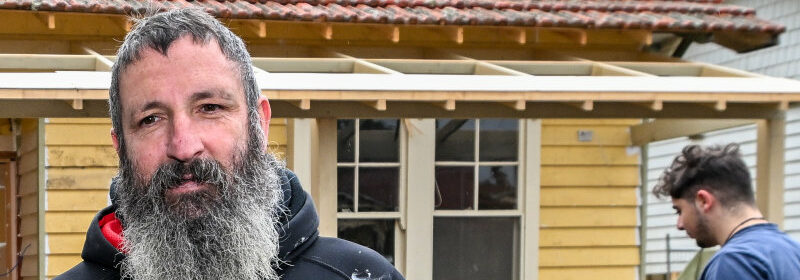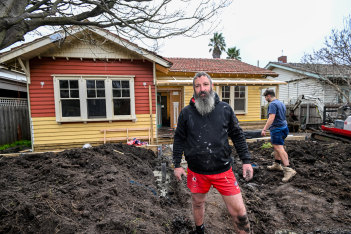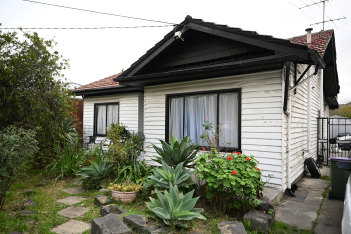‘It’s derelict’: When is the family home not worth protecting?

Save articles for later
Add articles to your saved list and come back to them any time.
Carpenter Jack Camilleri is ankle-deep in mud at his mate Tom and Margaret West’s century-old weatherboard house in Spotswood.
This house was one of 250 “war service” commission homes built in Spotswood between 1920 and 1930, to house families of “small means”. Just 28 remain.
Carpenter Jack Camilleri working on a house in Spotswood.Credit: Joe Armao
Camilleri, West and their crew have spent months painstakingly restoring this home, removing an “ugly” front carport, replacing weatherboards and installing a verandah to bring the house back to its original character. But if they’d started the job later this year, they might not have been able to touch the exterior.
For the first time, homes like this one would be covered by a strict heritage overlay under plans announced by Hobsons Bay Council to add another 196 homes and businesses to its list of significant properties.
Mayor Tony Briffa says the overlay would help protect Spotswood’s character, by requiring people to apply for a planning permit for building works and demolitions. This would include installing solar panels on the street-facing aspect of roofs.
“The planning permit process allows council to assess whether a proposed development or demolition will impact on the heritage significance of the place,” Briffa said.
Even though their restoration could have been much more difficult if they began it a year later, the Wests support the concept. Tom says: “I think they should do more of it. When you drive around the streets, it looks like people have just stepped back and said, ‘how many properties can I get on this block?’ They’ve got to put a stop to it somewhere.”
Others aren’t so sure. A neighbour, who wouldn’t give his name, was frustrated he couldn’t knock down and build on one of his properties. “Why can they do it and I can’t?” he said, pointing at a townhouse development down the road.
In Hudsons Road, Lesley Bowen describes herself as devastated by the proposed addition of her property to the heritage register. She had hoped to knock down her house, which she described as “derelict”, subdivide her large block, and build units for herself and her three children.
“I’m 67 now, and I’m a single mum. I worked my guts out, so my kids would have something.”
Lesley Bowen had hoped to knock down her “derelict” home and build units for herself and her children.Credit: Joe Armao
Bowen has appealed the listing over her house, which she says no longer has the original fixtures that qualified it for heritage listing, including the fireplace and chimney.
Local history buff and writer Peter Dewar says it’s possible to trace the progress of Victoria’s industry through the industrial and residential buildings of Spotswood, a pocket-sized suburb of fewer than 3000 people.
They range from modest cottages built for workers, to the grand old pumping station credited with transforming “Smellbourne”, as pre-1897 Melbourne was known, into a modern city with a functioning sewage system.
“[Spotswood] holds the story of the unfolding of industry in Victoria; it’s important nationally,” Dewar says.
“I shake my head sometimes and think, someone’s going to look back and say, ‘what were those people thinking? They bulldozed most of their history to make way for new developments and apartments’.”
But the history of this little suburb flanked by the West Gate Bridge – and the stated aim of the local council to protect it – is also creating a tension that’s been felt across Melbourne.
The Legislative Council’s Environment and Planning Committee released an interim report on planning protections last year.
One of the major themes that emerged from public submissions was from owners of heritage-protected properties, who felt “unfairly disadvantaged and not adequately supported in relation to heritage obligations and restrictions”.
Critics say heritage overlays could frustrate the Victorian government’s aim to direct the majority of residential growth into established suburbs through “infill” (with just 30 per cent in growth areas).
“Victoria is currently in the grip of a housing affordability crisis with the inadequate supply of new housing at its heart,” the Property Council’s Victorian executive director Cath Evans said.
“Locking up land in intricate planning overlays and red tape only serves to make these areas even more unaffordable for the first home-buyers and renters that wish to live in their own communities.”
A push in Maribyrnong to impose heritage overlays on almost 900 homes was abandoned last fortnight, after a concerted campaign by residents.
Briffa says the proposed Maribyrnong overlay would have affected more properties than in Spotswood, and would also have rezoned some areas.
“Heritage houses in Spotswood are unique as they demonstrate the key phases of development in Spotswood during the late Victorian, Federation, Interwar and Post WWII period, which was a consequence of the development of industries and railway-related infrastructure in the area.”
Among the other buildings that would be protected by heritage overlays are the Spotswood State School, and 87-89 Hudsons Road; one of the first shops in the area, which now operates as a café.
A planning panel will consider residents’ submissions on the proposed heritage overlays in hearings beginning in late July.
Get the day’s breaking news, entertainment ideas and a long read to enjoy. Sign up to receive our Evening Edition newsletter here.
Most Viewed in National
From our partners
Source: Read Full Article

